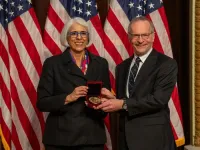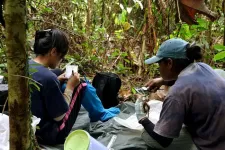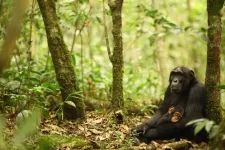(Press-News.org) Key takeaways
Both intuition and past research suggest that whether people deem someone trustworthy depends on that person’s past behavior and reputation for betrayal.
In a series of experiments, psychologists found that subjects regarded those who previously exhibited that behavior as less trustworthy. However, when the betrayal benefited them or had no effect on them, participants regarded the betrayer as trustworthy.
This pattern was largely consistent across the types of relationships studied: friendships, romantic relationships and professional relationships.
Imagine this scenario: Two people cheat on their partners with each other and then leave their partners to be together. Should they trust each other, or “once a cheater, always a cheater”?
Intuition and past research suggest that whether people deem someone trustworthy depends on that person’s past behavior and reputation for betrayal. But now, new work from psychologists at UCLA and Oklahoma State University is helping to explain why people might nevertheless trust certain cheaters and other betrayers.
When we benefit from someone’s betrayal, we tend to still regard that person as inherently trustworthy, the psychologists reported in a study published in Evolution and Human Behavior. Their experiments found that, although subjects tended to regard people who betrayed others as generally less trustworthy, when a person’s betrayal benefited the subject, that person was still thought to be worthy of trust.
At question is the role concepts like “trustworthiness” play in our relationships. According to the research team, inferences about someone’s trustworthiness are used for making adaptive choices — that is, choices that benefit us. So, while people might be attuned to whether someone has betrayed others in the past, the researchers predicted that people would also be attuned to certain relationship-based factors that impact how that person is viewed/trusted.
“Making decisions about whom to trust based only on whether that person has betrayed someone else might not be the best way to determine whether or not I can trust someone,” said study co-author and UCLA professor of psychology Jaimie Krems.
“Sure, if someone betrays other people, that could be a valuable cue that they might betray me — but not always. For example, think about that friend who always tells you other friends’ secrets but doesn’t share yours. This friend is betraying other people but enriching you with information,” Krems added.
This was the researchers’ main contention: The mind should be attuned to whether someone has a reputation for betrayal, yes, but also to how someone’s betrayal affects you.
The researchers designed experiments to test whether people deemed targets more trustworthy when the targets avoided betrayal — but also when the betrayal had different impacts on the subject.
In one series of experiments, participants were randomly assigned to read one of three vignettes describing their interaction with a target. The first experiment involved sharing secrets among friends, while the second involved romantic infidelity. The third described an interaction in the context of international relations, with participants acting as CIA agents attempting to cultivate a French official as a source.
The targets exhibited one of three behaviors: they did not betray anyone when they had the opportunity; they betrayed another person to the participant or betrayed the participant to someone else. For example, some targets did not share a secret, others shared a secret about someone else with the participant, and still others shared the participant’s secret with a third party. After reading the vignettes, participants rated the target’s trustworthiness on a 7-point scale with questions such as, “I would trust the target to keep my secrets.”
As intuition would predict, across all types of relationships, participants regarded targets as more trustworthy if they did not betray anyone and less trustworthy if they did. But people who betrayed were not all deemed equally untrustworthy. When betrayal benefited the participants, they still considered the target trustworthy. This pattern was largely consistent across friendships, romantic relationships and professional relationships.
The findings upheld the researchers’ hypothesis that judgments of trustworthiness are partly a reflection of the person’s disposition and idiosyncratic factors specific to the participant and the person at hand.
The findings show that while people might start with lofty ideals when it comes to trusting people, what they do in practice is often based more on self-interest.
The research was funded by the National Science Foundation.
END
Researchers find betrayal doesn’t necessarily make someone less trustworthy if we benefit
2025-01-09
ELSE PRESS RELEASES FROM THIS DATE:
Pet dogs often overlooked as spreader of antimicrobial-resistant Salmonella
2025-01-09
UNIVERSITY PARK, Pa. — Antibiotic-resistant Salmonella is a serious public health concern that has increased in recent years as the bacteria have developed ways to survive drugs. According to the U.S. Centers for Disease Control and Prevention, people can get Salmonella from eating contaminated food products or from infected people or animals — typically via unintentional contact with feces via touching hands or stroking a pet. However, a team of Penn State researchers have found that household dogs are an overlooked transmission point for zoonotic pathogens such as nontyphoidal Salmonella, which can cause diarrhea, fever and abdominal cramps, with some ...
Pioneering new tool will spur advances in catalysis
2025-01-09
For decades, catalysts have been unsung heroes in daily life. These workhorses transform a starting material into a product or fuel with lower energy, like the yeast in bread making and human-made catalysts for converting raw materials into fuels more efficiently and sustainably. A promising class of these helpful substances, called single atom catalysts, has emerged, and researchers need new methods to better understand them. More specifically, they want to know how the structure of the sites where chemical reactions occur, called active sites, affects the catalyst’s ability to speed up the chemical reaction rate, known as the activity.
In an important step forward, researchers ...
Physical neglect as damaging to children’s social development as abuse
2025-01-09
CHAMPAIGN, Ill. — While physical neglect is understudied compared to physical, sexual or emotional abuse, neglect is just as damaging to children’s social development, a new study indicates.
More than 9,150 individuals, nearly 41% of whom retrospectively reported some form of maltreatment before age 12 or reaching the sixth grade, were included in the study, published in the journal Child Abuse and Neglect. The project explored the impact of abuse or neglect on three dimensions of children’s structural peer relationships — whether maltreated youth were less social/more withdrawn, less popular with or avoided by their peers and how ...
Earth scientist awarded National Medal of Science, highest honor US bestows on scientists
2025-01-09
UNIVERSITY PARK, Pa. — Richard Alley, Evan Pugh University Professor of Geosciences at Penn State, was awarded the National Medal of Science at a White House ceremony on Jan. 3.
Alley was one of 23 individuals and two organizations awarded the 2025 National Medals of Science and National Medals of Technology and Innovation, the nation’s highest honors for achievement and leadership in science and technology.
“Dr. Alley is deeply deserving of this most prestigious honor, and it is heartening to know that our nation sees in him what the Penn State community has known for decades,” said Penn State President Neeli Bendapudi. “Dr. ...
Research Spotlight: Lipid nanoparticle therapy developed to stop tumor growth and restore tumor suppression
2025-01-09
Yang Zhang, PhD, and Jinjun Shi, PhD, both of the Center for Nanomedicine and Department of Anesthesiology, Perioperative and Pain Medicine at Brigham and Women’s Hospital, are co-senior authors of a paper published in ACS Nanoscience Au, “Lipid Nanoparticle Delivery of mRNA and siRNA for Concurrent Restoration of Tumor Suppressor and Inhibition of Tumorigenic Driver in Prostate Cancer.”
How would you summarize your study for a lay audience?
Most cancers occur when there is an imbalance of cellular growth and inhibition, causing cells to grow rapidly and form tumors in the body. For example, ...
Don’t write off logged tropical forests – converting to oil palm plantations has even wider effects on ecosystems
2025-01-09
A research team led by the University of Oxford has carried out the most comprehensive assessment to date of how logging and conversion to oil palm plantations affect tropical forest ecosystems. The results demonstrate that logging and conversion have significantly different and cumulative environmental impacts. The results have been published today (10 January) in Science.
Understanding how different aspects of tropical forests are affected by logging and conversion to oil palm plantations is important for identifying priority habitats for conservation and restoration. It can also help aid decisions on land use – for instance, whether a logged forest should be ...
Chimpanzees are genetically adapted to local habitats and infections such as malaria
2025-01-09
Chimpanzees bear genetic adaptations that help them thrive in their different forest and savannah habitats, some of which may protect against malaria, according to a study by an international team led by UCL researchers.
Chimpanzees are our closest living relatives, sharing over 98% of their DNA with humans, and the scientists say that their findings, published in Science, can not only teach us about our own evolutionary history, but also about the biology of malaria infection in humans.
Chimpanzees are endangered ...
Changes to building materials could store carbon dioxide for decades
2025-01-09
Replacing conventional building materials with materials modified to store carbon dioxide could move the planet closer to net-zero greenhouse gas emissions, according to a new study by Elisabeth Van Roijen and colleagues. The researchers calculate that full replacement of conventional building materials with these CO2-sequestering alternatives could store as much as 16.6 ± 2.8 gigatons of CO2 each year – an equivalent to about 50% of the anthropogenic CO2 emissions in 2021. Removing carbon dioxide from the atmosphere, along with decreasing emissions, is important for slowing ...
EPA finalized rule on greenhouse gas emissions by power plants could reduce emissions with limited costs
2025-01-09
In this Policy Forum, John Bistline and colleagues analyze the potential impacts of the U.S. Environmental Protection Agency’s finalized power plant rules regarding greenhouse gas emissions. Using nine models of the U.S. electric sector and energy systems, the researchers found that the rules would speed up the reduction of emissions in the power sector. Under the rules, the levels of carbon dioxide emitted by the sector would be 61%-81% below 2005 levels by 2040. Under current policies, emission levels would be 51% to 83% below 2005 levels by 2040, ...
Kangaroos kept a broad diet through late Pleistocene climate changes
2025-01-09
Samuel Arman and colleagues’ close examination of tooth microwear among living and extinct kangaroo species suggests that most of the species living in Australia during the Late Pleistocene had a broad, generalist diet rather than being specialized grazers. This broad diet likely allowed them to survive the glacial-interglacial cycles that drove fluctuations in vegetation on the continent. The findings add more evidence to the idea that human hunting, rather than failure to adapt to climate changes, ...




